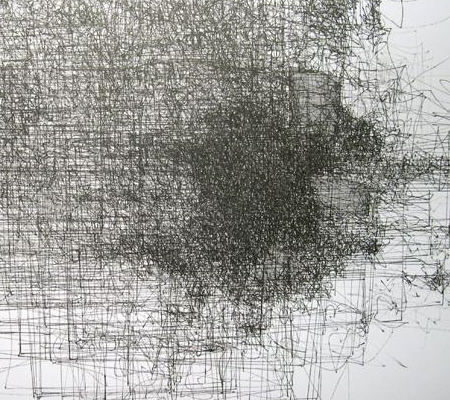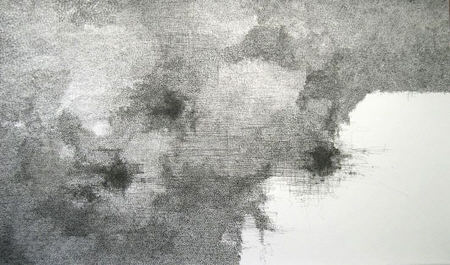
Complex #4 (detail), Nelleke Beltjens
There was a fascinating exhibit in Bozeman of drawings by three young European women–Nelleke Beltjens, Hedwig Brouckaert, and Jorinde Voigt–curated by independent art historian/critic/curator Peter Lodermeyer. Titled re/pro/ducing complexity, the multiple readings of which are all applicable, it consists of recent work that is varied, visually appealing, and intellectually stimulating.
The subject of complexity is dear to my heart, both because it is one of the major issues in some of my photography (especially the Sourdough Trail series), and also because of a long-standing interest in all kinds of complex systems. Confronting it in the context of drawings was very instructive for me; it forcibly drove home the dramatic difference in the way complexity comes about in drawing and photography.
In drawing, of course, complexity is built up over a long stretch of time. It takes a good deal of effort to develop interesting complexity; it may be the rule that the faster one works, the less successful the result. Whereas in photography it’s very easy to capture an image that’s fantastically complex; what’s hard is to find enough organizing structure—simplification—to make it appealing. One works in opposite ways in the two mediums: from simple up or complex down. So I was especially intrigued by this chance to look at complexity in drawing.

Complex #4, Nelleke Beltjens
The most intuitive in her approach, Nelleke Beltjens makes many thousands of lines, typically on large sheets of paper, as in the image above from her Complexity series (the opening image is a detail of this). Her process is to start repeatedly from one or two concentration regions, and draw without prior planning of what will develop. She reacts to the drawing as it evolves. An amusing side note: Beltjens drawings reminded me of Hugh Macleod’s drawings on business cards; when I checked his web site for a link, I discovered he’s recently begun doing large paintings as well.

Magazine Figures (blue), Hedwig Brouckaert
Brouckaert is more algorithmic in approach. Typically she uses one or a few popular magazines and traces nearly superimposed outlines of the figures in successive photographs, proceeding page by page through a whole magazine. The result is an abstract, nearly illegible accumulation which “neutralizes” the mass market images, while emphasizing the linear qualities of the drawing.

auktion, Jorinde Voigt
Voigt’s work appears more “disciplined” and precise; it is based on intricate repeated curves in a manner suggestive of geometrical diagrams, or computer-aided design (CAD) drawings. They were very elegant; not as busy as the others, but alluding to much through their refinement. Their complexity was less visual, more conceptual like that of a complicated mathematical formula they might be illustrating.
A curious commonality is that all these works seemed to be to some degree about space. Imagining myself making drawings like those of Beltjens, which could be considered very elaborate doodles, it seems to me that I would think of each extended, convoluted line, as I drew it, as a kind of personal journey. From a dense home region, I might explore different places: crowded, social ones where I’m hardly noticed, or wilderness where my mark transforms the space. Brouckaert’s drawings rely the arrangements of figural superpositions in the two-dimensional space of the paper to lend liveliness and suggest relationships among the groups. Finally, Voigt’s arrays of curving lines almost compel us to imagine them in three dimensions.
In terms of complexity, each artist appears to be exploring limits of how far one can go without going too far. Too much complexity can become perceptually overwhelming and we lose interest. I think that begins to happen to me with the almost over-drawn ballpoint on canvas works of Il Lee we learned of from Leslie. In a sense, going so far that we can’t grasp any structure and marks seem virtually random is actually to become less complex; there is actually less information (that we care about) there. Do we each have a personal comfort zone with regard to complexity? If so, mine is about at the level where these drawings operate.

Steve,
Fascinating stuff and your ruminations on it are evocative. I need to ruminate on your ideas and the work a bit for a while, but i wanted to say thanks for the insights.
As it happens, today’s work, not quite intentionally, came right back to complexity. More to follow in a couple days.
Steve:
There’s a kind of hodge podge, a horror vacui, where the overall is less than the sum of its parts, that can cause me great discomfort. I’ve been to the Barnum Bailey and experienced something akin to a fever dream.
Jay,
That’s a very perceptive comment, and makes me realize that what I enjoyed most in seeing these drawings was looking into the intricate details. I’m not sure how well the whole would wear over time. But I may not have selected the best representatives. The busiest I showed was by Beltjens, but others of hers have much more negative space, such as this one:

At high school, I did some artwork by ‘doodling’ with the intent of eventually allowing a recognizable structure evolve in the mist of the lines. It was a little bit like what we could do with the now defunct website ‘dreamlines’ where recognizable shapes evolved from hatched lines.
My prejudice against the art shown here may arise from having seen spiraling lines generated from computer modeling of geometric equation. In a month, I may be able to show examples of what I mean.
In other words, so far, I fail to see the deeper meaning in the art shown here. It may help seeing the originals. I am open to learning more about it.
Birgit,
Ahh, deeper meaning… I have to agree that any meaning here is rather elusive and intellectual. Perhaps the pondering of the doodle is exactly what there is–which I suppose could be a lot or almost nothing, depending on the doodle. I do have a sense of real personalities behind these drawings, so there is a connection to the artist for me. On the other hand, I’m not sure how much deeper meaning can be attributed to, say, a stunning photograph of a natural scene. Sidestepping this slippery question, I could say that I probably wouldn’t make space for these on my wall, but I definitely enjoyed seeing them in exhibit.
Steve,
The images are growing on me. Perhaps, some day, I too can see them in an exhibit.